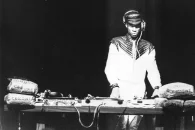The Bridge: On the Wheels of Steel
Author and dance critic Michaelangelo Matos says remixing is like songwriting: there’s no one right way to do it.
[This edition of my Hit Parade—“The Bridge” bonus series is available to Slate Plus subscribers only. A link to the episode show page is below. To sign up for Plus—and tell Slate that Hit Parade sent you!—visit slate.com/hitparadeplus.]
In this mini-episode of Hit Parade, host Chris Molanphy is joined by Michaelangelo Matos, author of The Underground Is Massive: How Electronic Dance Music Conquered America and Can’t Slow Down: How 1984 Became Pop’s Blockbuster Year. Matos explains how remixing evolved from a physical artform—DJ Kool Herc manipulating turntables, or producer Shep Pettibone remixing a New Order record with grease pencils and spliced tape—to an act of total electronic reinvention: albums like the Avalanches’ Since I Left You that are literally impossible without accessible samplers and digital editing tools. Some DJs will reduce a track to nothing but the original vocal, then rebuild it from the ground up. Sometimes even the vocal is rerecorded! “Remixing is like songwriting,” Matos says. “There’s no one way to do it.”
Next, Chris quizzes a Slate Plus listener with some music trivia, gives him a chance to turn the tables with a question of his own, and previews next month’s full-length episode. Slate Plus members can sign up for a chance to be our trivia contestant on a future episode here.
Podcast production by Benjamin Frisch.
Content retrieved from: https://slate.com/podcasts/hit-parade/2022/03/remix-evolution-revolution.

